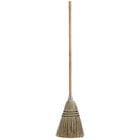

While I did not follow the exact method proposed, as I wanted to make a smaller broom than what the author provided steps for, I did glean some good tips. Mother Earth News has a good article about making brooms.

After ample sanding, I treated my handle with a few coats of linseed oil and considered it done. Such details, however, do depend on the overall aesthetic or design that you want to achieve. This section should be smaller in diameter than the actual handle, so that when you attach the broom corn, it is more likely to be flush with the handle. If you are making a handle, it is important to leave a few inches of wood at the end of the handle to which you can attach the broom corn. The wood was already well cured by the forest so I didn't have to take any steps before making it into a simple handle on the lathe. I used a piece of dead cherry I found in the forest. While the stalks are drying out, its a good time to make the handle. The broom handle, made from cherry wood on the latheīrooms require a handle of some sort. This is important so that no moisture is trapped with the stalks are then bound together in the broom which could encourage mold to grow. While somewhat time consuming, it is not difficult, and easily something that could be done while talking with a friend or watching a movie, as long as you have both hands free.Īfter removing the seeds, I let the stalks thoroughly dry out.

Since the seed has yet to be fully mature, this step proves a little more laborous than if the seed were ripe and ready to be realeased. But, that is in addition to threshing the seed from the stalks, soaking the stalks, making the handle, and of course growing the broom corn.Īfter harvesting the stalks, the first step is to thresh the seed. The actual assembly of the broom only took me about 30 minutes. I am quite pleased with what I created, given that it was the first attempt. Earlier this summer, I finally got around to actually making a broom. While the broom corn I've been growing is shorter than what may be able to be grown in Tennesse, it is functional nonetheless. Considering that in these two years, the seeds have yet been able to reach maturity before they need to be harvested because of frost, I would primarily attribute the small sized broom corn to the length of the growing season. What I have been able to harvest just before the first frost threatens in October, is on average about 12 inches, with some plants producing longer tassles. For example, the broom corn in the broom my mother purchased from the Amish family back when I was 10 was about 2 feet in length. The material I harvested last year and the year before were shorter than what most standard-sized brooms utilize. Broom corn is slow to take off in the spring (I plant it after the last frost), but in late August and into September when most everything else seems to be begging for more water, the broom corn stands tall and continues to grow steadily. Sorghums, native to central Africa, are quite drought tolerant, but also are frost intolernat. It is these tassles, also referred to as seed stalks, that broom-makers use to make their craft.īased on the last few years in the test plot, broom corn does quite well here. Unlike corn, the end of the tassles hold the seed heads, as opposed to just the male flower. Similar to corn, broom corn has a tassle that emerges out the top of the plant. The name is a bit confusing, as it is not a type a corn, but rather a type of sorghum. Over the past few years, I have dedicated a small section of the garden to broom corn-the common name for the plant traditionally used to make brooms.

She assured me, that a good broom was well worth that price, as it would last a lifetime. I recall that she paid around $100 for it, maybe a little under. She eventually picked one out that suited her needs. One summer when I was about 10, I remember going to visit an Amish family in Pennsylvania Dutch Country and waiting awkwardly outside while my mom surveyed the hand-crafted brooms. She accomplished this task by simply commenting with far more frequency than one might think the humble broom deserves, how much she appreciated good brooms, and how hard they are to come by. Growing up, my mother instilled in me an appreciation for good brooms.


 0 kommentar(er)
0 kommentar(er)
